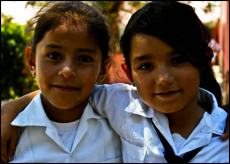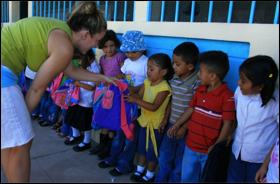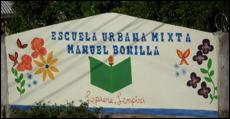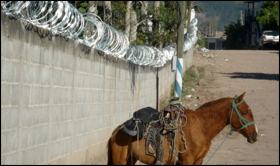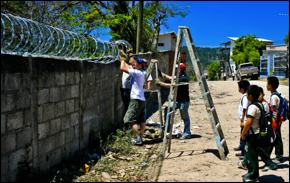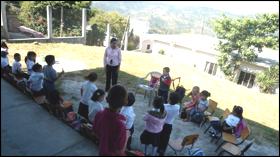It’s the first full day in Honduras and the gang is up bright and early, mostly thanks to the nearby roosters that seem to have a dysfunctional internal clock. Typically, unscheduled downtime is very scarce while in Lepaera; however, because it is the very first day we’ve awakened in Honduras, we have yet to purchase our project supplies. There are several reasons why we don’t purchase our project materials in the States: 1) could you imagine the nightmare of transporting the materials on the plane?; 2) supplies sometimes tend to be cheaper in Honduras; and, most importantly, 3) it is a huge boost to the local Honduran economy.
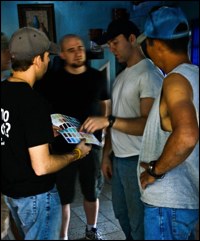
Choosing the color palette.
After the group, with input from both Profe and Carias, decided on the color palette for the elementary school, all six boys (with Carias as their guide) depart for several different shops and hardware stores dispersed throughout the region to gather the needed materials. The colors we settled on were a sky blue color (“celeste”), which apparently is quite the popular hue in Lepaera, and a subtle off-white tint to use as trim. With the boys preoccupied, all of the girls were anxious to get out into the town and see the sights. Marlen, Carias’ youngest daughter, resumed her role as our tour guide and took us to the weekly Sunday market in the heart of Lepaera.
This time last year, Carias accompanied the girls on our Sunday morning jaunt into the town, and while on the tour, he was very excited to show us the construction progress of the town’s first major bridge. Well, approximately 365 days later, the bridge is finished! There are no vehicles of any kind allowed on the bridge; it’s for pedestrians only.
At first, we were so thrilled to walk across it, then after several steps, fear set in. The bridge is suspended over a very steep ravine and primarily consists of slightly weathered wooden boards nailed together and supported by a lightweight rafting. I think the word “precarious” would be an
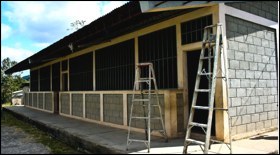
Lepaera's kindergarten building before painting.
understatement. If someone hops, skips, or shifts their weight too suddenly at the other end of the structure, then the movement swiftly ripples to the opposite end, effectively knocking any unsuspecting pedestrian off kilter. This bridge would be a perfect fit for an amusement park. Although, it is of note, the bridge did not seem to bother the natives in the slightest.
After a quick tour through the market, the girls returned home just in time for the boys’ arrival. All 15 of us load up into two vehicles and head to the elementary school located in the mountains. Because it’s Sunday, the school is not in session; nevertheless, several neighborhood children caught word of our presence and ran over to the school to offer help.
This particular school houses two kindergarten classes of approximately 20 students each. Our task was to peel off the current wall decorations – colored paper glued to the cinderblock walls – and then to paint the exposed cement. This part of the project was easier said than done. We all struggled to remove the industrial adhesive holding the paper to the walls. The classroom teachers were both there to supervise our work, and they mentioned that the paper had been there for a couple of years at least.
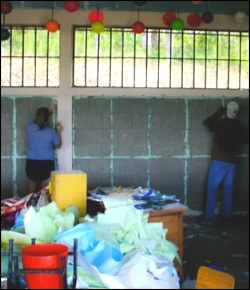
The hardest part of the job was scraping off the colored paper that had been glued to the cinder-block walls.
Eventually, we came up with the bright idea to buy metal scraping tools from a local hardware store because, quite frankly, our fingernails couldn’t take much more picking and peeling. Even the metal scrapers were not sufficiently removing this super glue. Finally, we discovered the perfect formula for the job: water + scraping tools. Although, by the time we discovered the winning combination, it was time to stop for lunch.
One of the best constants of the trip is the routine nature of our meals. Profe would never allow us to go without eating for more than a few hours. So, the group begins the descent to casa de Carias for our lunchtime meal. We quickly learned that being transported to the mountain school was a treat and that from now on walking is our primary method of transportation. This isn’t a bad thing because it lets us walk through the town and see more sights and fully take in our surroundings. Also, walking down the large hill isn’t nearly as laborious as walking up it. 🙂
Lunch today was particularly spectacular and everyone devoured their respective portions very quickly. We do have a few vegetarians in our group and the Carias family is always very sensitive and accommodating, despite a few quips from Carias that he doesn’t understand why someone would not prefer meat to a salad. On today’s menu was a type of meat patty placed into our favorite homemade tortillas, the best potato salad imaginable, and a side salad replete with fresh tomatoes. It was perfectly delectable and great fuel to inject into the next few hours of labor. Our lunch breaks typically last an hour, and around 1 p.m., we begin the trek back to the kindergarten school.
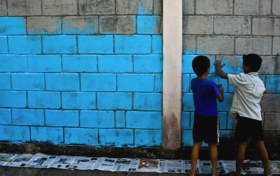
Boys from the neighborhood boys pitch in to help.
Once at the school, we break ourselves into two teams: scrapers and painters. One classroom had been completely scraped before lunch and it was now ready for paint.
Side note: sometimes, around Gonzaga, our group gets asked why our projects always involve paint. Well, because buying paint, ladders, turpentine, and numerous brushes is incredibly expensive and quite an undertaking. Not to mention the cost and time of labor. Moreover, we ask the town of Lepaera which projects they would most like us to perform and it just so happens the projects usually involve painting.
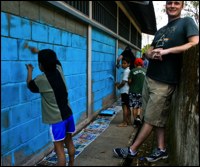
Someone has to supervise.
While painting, several group members bust into song and begin singing a few 80’s tunes a cappella. The neighborhood kids were at first puzzled, but then began to find our singing very entertaining. Also, Lady Gaga and the Black Eye Peas are very popular groups in Lepaera, which is quite interesting given that not very many people understand or speak English.
Eventually, both groups are painting. We decide to divide and conquer by having half of the members begin painting the outside of the school while the others focus on the classrooms. Soon, the members who elected to paint outside, become mere onlookers as three neighborhood kids beg to take over their painting responsibilities. It was an incredible bonding experience between the group and the kids. While there is a pretty significant language barrier, fun and laughs were had by all.
Around 5 p.m., it is quitting time for the day. We clean up ourselves, the materials, and the neighborhood kids and head for home. This year, Honduras seems to be unseasonably hot and the sun had been beating down on us for several hours now, which really added to our exhaustion.
Profe had dinner ready and waiting for us when we arrived home. Tonight we had two types of beans and cheeses and as many tortillas we could stomach. After dinner, MP was left to our own devices for entertainment. One of our group members, Julie Wheaton, came up with the best game for us to play – Celebrity. It’s a game in which each player (all 15 of us) writes down the names of three famous people. We put the names into a hat and played three different rounds. In the first round, we had to describe the name on the piece of paper without saying the person’s name. In the second round, we had to describe the person with one word (typically, it’s three words, but we tried to make the game more challenging). And, in the third round, we had to act out the name similar to the game of charades. It was a blast. After the game, however, everyone was absolutely wiped out and we called it an early night.

